“Wisdom...is not even useful...It is not a servant...one cannot attain wisdom; one cannot conquer, capture, and comprehend wisdom...It exists only where there is abundance, only where wisdom is allowed to overflow out of its plenitude...To prepare a dwelling place for wisdom is to put down roots in the heart of reality.”
(Raimon Panikkar, A Dwelling Place for Wisdom)
Historians of playing cards, although not unanimously, maintain that two card decks, the cards of Vieville and of Noblet, 121 dating their creation circa 1650, must have been the joining link between the Italian and the Marseilles Tarot. These last, according to them, appeared only some decades later in the future and despite their name, would not be created in Marseilles. These historians usually maintain that:
“The Noblet deck marks a further step ahead in the creation of the Marseilles model and at the same time takes a giant step backwards of over a century : many of the figures in fact seem copied from the Cary sheet, of the Milanese Tarot of the early 1500’s, the Visconti-Sforza. However, since no complete Milanese, nor French, Tarot decks from the XVi and XVII century have been handed down to us, it is not possible to know at which point Noblet detached from the model which he had adopted. 122 ”
In brief, historians believe:
1. That the Tarot of Marseilles derives from the Renaissance Visconti Tarot.
2. That it does not come from Marseilles.
The first modern deck considered typically “Marseilles Tarot” is that of 1672, of François Chosson. The name of the cardmaker and the date of production (“1C72”) appear, as usual, in the Two of Pentacles. Yet, apart from its place of origin, some scholars have doubts regarding its dating. In fact, observing this card, we see that two of the four numbers are deteriorated: the initial “1” and the final “2” appear authentic. Therefore, the presumed (for its “C” form) “6” and the “7” are a problem.
Why are they in such a state of ruin?
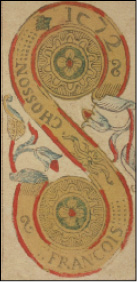
Fig. 1
The Chosson Tarot
It is possible to hypothesize that the wooden block, the original matrix of the features, was scraped in order to erase the two central numbers, a fact that might cause one to imagine an error, or clumsiness, of the printer. However, regarding the colours, it would be impossible to speak in any manner of inattention, but rather of incompetence, as these Tarot cards are truly a professional failure. If the features of the illustrations, as are the names and numbers, are traced with notable finesse and without a smudge, the application of the tints, on the contrary, as the image here shows, was done with no respect for the borders of the features and the limits of the margins, its appearance decisively blighted. This could only have been done by an inexpert printer, a different person from the initial engraver who, to judge from his work, was of a Benedictine precision... Therefore, we might suppose that this second cardmaker cancelled, and engraved again, in a maladroit manner, the two central numbers, in order to mark the new version.
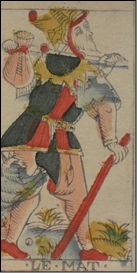
Fig. 2
Chosson Fool
Why would he have changed the second number representing the century, when he could have simply changed the decade? The fact that the second number as well was changed indicates that the wooden matrix was not engraved in the 1600’s but earlier, otherwise there would have been no reason to alter it. Furthermore, as the letters of the surname Chosson do not correspond perfectly to those of the name François , (neither in dimension nor in form, as in the evident case of the letters N and S), we may suppose that a modification was also made at the point in the printing relative to the surname; and Chosson would have been none other than the later addition of this seventeenth-century cardmaker. Would, then, a certain François , the author’s first name, have created this copy before the year 1600? In 2001, thanks to certain documents published in the 1800’s, it was ascertained as well that the card deck, at least the version that we know today, is definitely of Marsellaise origin. Yet, let us remember that researchers share the idea that the decks of Noblet and Vieville were the trait d’union between Italy and France, the bridge between the Visconti and the Marseille Tarots, the first deriving from the second and of which the Chosson deck must be the first direct evidence. Merely browsing the list of cardmakers, from 1631 authorized by the King of France to form a corporation but whom we know to be more ancient still, we realize how numerous must have been the decks that have been completely lost. Consequently, it is legitimate to ask, how is it possible to affirm so assuredly that the Marseilles Tarot is of the seventeenth or eighteenth century and that it necessarily derives from the Italian model? Might we not suppose the opposite? The master cardmakers in France were well present even before the fourteen hundreds: faced with a presence so numerous, for the mere fact that up until now, we have not found decks of that period, are we authorized to think that there could not have been any? Obviously, one is not forced to embrace this theory, which seems to us a rigid sort of speculation and subject to obvious contradictions, as it is based only on certain presuppostions, for example the Renaissance origin of the Tarot. Studying more closely the story of these images, in fact, we have the impression that no one wishes to ascertain a truth different from the one commonly accepted, not so much for the lack of reliable sources, but in order to not risk the collapse of the academic framework built up around it. Despite the presence of numerous historical incompatibilities, as we saw in the preceding chapter, it would seem that these have not been noticed or, much worse, have voluntarily not been considered.
We understand that for historiographers, probably already in difficulty in trying to overcome the prejudice according to which the Tarot cannot be traced, unless as a phenomenon of “secular degeneration”, to playing cards, the expression of their history as it has been presented here up to this point must seem quite impossible. Yet, in complete accord with the Tarot’s Coded Structure (which we invite every sincere researcher to know and study in depth in order to avoid the risk of a useless apodictic judgement) we wish to illustrate another vision, which rests on a fundamental principle:
The
Marseille Tarot is much more ancient that the Italian Tarot, which, contrary to what has been maintained up until now, is a later copy of the first
.
Of the Marseilles Tarot, manufactured in diverse French regions and neighbouring countries such as Belgium, Switzerland, or Germany, there was abundant proof from the seventeen hundreds forward. The copies, created in the various epochs by diverse master cardmakers and printers, have many characteristics in common. Comparative analysis reveals the presence of a common original Canon , a group of similar characteristics present in the many decks created. Over the centuries, however, the authors heterogeneously distanced themselves from this Canon . The cardmakers, unknowing of the authentic symbolism of the Tarot, simplified it to the extreme, introducing, often and chiefly involuntarily, various errors into their works, which, in a cloning process, were transmitted to successive generations. For this reason, many Tarot decks are only copies of more ancient ones, in which the repetition of the same inaccuracies bears witness to the reality of the process of mere duplication. Other master cardmakers, however, fully conscious of their duty to respect the authentic symbolism, produced decks in which the features and colours, identical and superimposable among themselves although with some difference in the figures, are quite close to the same Tradition. In this case, it is not a process of copying and it can be deduced that these Tarot cards, quite homogeneous among themselves, have a common and ancient source.
In synthesis, apart from other possible and potentially correct sub-categories, the presence or absence of these general characteristics allows us to identify two large groups:
1. The so-called Marseilles Tarot;
2. The classic Marseilles Tarot.
The so-called Marseilles Tarot
In this first group, we include the decks that distanced themselves the most from the original canon, as those of Jean Jerger, one of the major manufacturers of the times, and his heirs: Renault, Kirshner and Blanche.
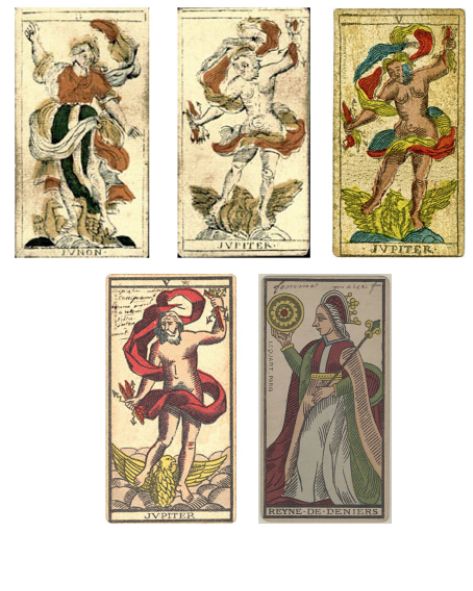
Fig. 3
Juno, Renault Tarot
Fig. 4
Jupiter, Renault Tarot
Fig. 5
Jupiter, Kirshner Tarot
Fig. 6
Jupiter, Lequart-Arnoult Tarot
Fig. 7
Queen of Pentacles, Lequart-Arnoult Taro
All of these decks were also improperly termed Variants of Besançon , the capitol of what is now the Franche Comté, from which, at the beginning of the eighteen hundreds, they were thought to have originated. We also find the decks of François Heri (1680-1746), a manufacturer of Solothurn in Switzerland, of whom are known two different decks, one from 1718, which copies the model of Noblet, and the second, perhaps of the same epoch, which is similar to the model of the so-called Marseilles Tarot . In the deck of Carrjat, printed in Chambery, although characterized by a different design than the canon-tradition Marseilles version, we at least find a Hierophant and a Priestess, whereas in the Besançon Tarot, in which these two figures have been substituted by Jove and Juno. We may also mention the decks of Rochias, manufactured in Neuchatel (Switzerland) or of Lequart, signed Arnoult, of 1748, recuperated, as we mentioned, by the editor Grimaud. All of these Tarot decks have been changed and modified.
For example, as we have said, the II Aracanum (the Priestess) and the V (the Hierophant) have been substituted by Juno and Jupiter; the Ace of Pentacles lacks the typical towers of the Marseille Tarot but more resembles a bellied trophy, etc. In general, the features and colours are less precise in their details and richer in ornamental elements. Although in these figures as well we find vestiges of the ancient tradition that spanned the centuries, the iconography appears concentrated on the artistic and decorative, rather than on the esoterical and sapiential.
In this second group, we include the decks of the authors more faithful to the primitive symbolism: The Tarot of Jean Pierre Payen, of François Tourcaty, and of Suzanne Bernardin, to mention but a few of the most typical. The first, who was born in Marseilles but went to live in Avignon, city of the Papal Seat, partially rejected the traditional canon. His cards, printed in 1713, are characterized by certain liberties and the evident wish to realize an aesthetic and artistic work as well. It is, however, clear that his deck was copied from other, more ancient decks, of which it conserves vestiges and essence. In the Tarot of François Tourcaty (1734-53), although not all of the codifications, while often referenced, are present, we can sense the work of an author rich in inspiration. The Tarot of Suzanne Bernardin (a female engraver, a notable fact for the epoch) is dateable to 1839 and is characterized by the presence of details and symbols correspondent with the common Canon .
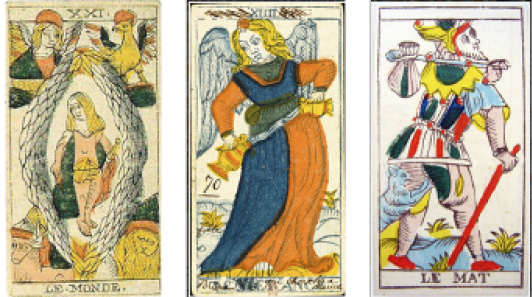
Fig. 8
World, Payen Tarot
Fig. 9
Temperance, Tourcaty Tarot
Fig. 10
Fool, Bernardin Tarot
Briefly then, all of these decks, the works of knowledgeable masters, are marked by an obvious adhesion to the features and authentic symbolism at the base of the Coded Structure . From this perspective, we believe that it would be well not to assume automatically that when we speak of cardmakers, we are speaking of those of the corporation, in professional terms as well as symbolical. For example, an apprentice was required to undergo a period of training which varied according to the city and the corporation (in Paris it was five years). After having terminated this experience, he did not become a master without having worked for a certain number of years as “companion”. Admissibility to the status of companion and of master, were subject to exams and tests, among which was the production of a test piece, a product that gave proof of his acquired capabilities. Obviously, all this did not derive exclusively only from practical and concrete professional requirements but was connected to a quite precise symbolism of which in fact the Cardmasters, with their craft, were the heirs and which furthermore, as we have seen before, bear a marked resemblance to modern Masonic hierarchy.
It has already been said that among them, the place of most prestige belongs to the author of a deck of superior quality, touchstone for all others, the illuminated master Nicolas Conver. Let us, therefore, illustrate the implications of the modern reconstruction of his deck.
Restoration of the Conver Tarot of 1760
There, have been countless techniques following one after the other over the centuries, first for the creation of the Tarot and later for playing cards. We presume that in ancient times they must have been written on parchment or engraved on wooden blocks; in the following centuries, manufacturers progressed from the use of blocks in pear-tree wood (or similar, for it’s soft but strong consistency) as matrix for the figures, together with coloured stencils (the pochoirs ), up until the 1800’s machine-imposed industrial revolution. In the figure underneath, a typical wooden print of the eighteenth century.
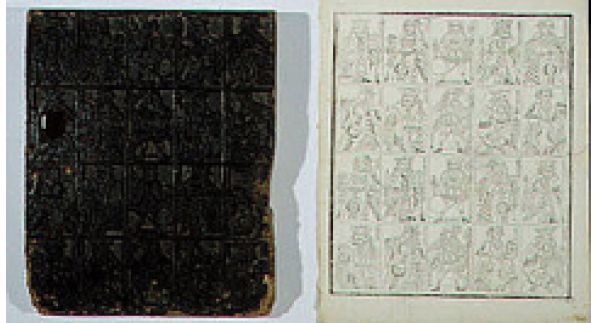
Fig. 11
Wooden printing blocks of the XVIII century
It is easy to imagine that Tarot cards today are illustrated and printed above all by means of digital instruments. The Tarot deck of Conver was published in the nineteen hundreds as well, with no attempt to recuperate the images or the colours. Observing the various editions, 123 as a matter of fact, it seems evident that the tints were often applied in a rough and unskilful manner and that part of the features, owing to the ruined state of the original prints, is technically imperfect. Thus, as in an ancient work of art, worn by time, one feels the necessity for reconstruction of the original form, that it may find again its splendour, in the same way, one who is fully conscious of the Coded Structure present in this deck would instinctively feel the need to perform a work of reconstitution and conservation of its images. Consequently, in order to restore them to a condition respectful of the ancient symbolism, the restitution of certain elements hidden by improper application of the colours or deteriorated by the partial attrition of the matrices, as well as the recuperation of the natural coloration in general, were carried out through digitalization of the antique illustrations (made possible with the help of modern technology). One of the most difficult aspects of this task was the meticulous restoration of the specific gradation of the colours, carried out with radiesthetic measurements that permitted re-establishment of the frequency level of the primitive tonalities, beyond the scope of the human eye.
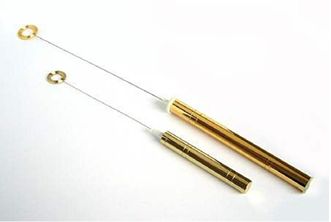
Fig. 12
Radiesthesic measuring instruments
Radiesthesia may be described as a psychic capacity to perceive various sorts of subtle energy emissions. It is based on the principle that bodies, be they mineral, vegetable, or animal, give off waves. Every body possesses its own radiation, and every person as well transmits it, being able at the same time to sense that of other bodies.
Radiesthesia. then, allows the acquisition of information in areas which transcend the sphere of the ordinary senses, based on the capacity of the radiesthesist to place himself in resonance, to tune himself as it were, with the vibrational level of the object of his research. Apart from other, more detailed considerations, which we delegate to specialized texts, it is possible to describe radiesthesia as a millenary science whose most ancient form of expression is rhabdomancy, the discipline utilized mostly in order to find appropriate sites for constructing houses and/or temples and to find underground water. We owe its modern definition, derived from the union of the roots radius (ray) and aistesis (sensitivity-perception), to Abbot Bouly at the end of the 1800’s, while its systemization in scientific terms is the work of Abbot Mermet at the beginning of the 1900’s. Today this practice is often applied in a distorted and uncontrolled manner as there are many who use the so-called “mental radiesthesia” in which the question is not asked of the object of evaluation but of the instrument utilized (for example the pendulum or another sort of tester) which actually has no autonomous capacity of answering and is merely a material extension of the operator. This is the reason for which the only correct modality is that of “physical radiesthesia” which, in contrast to the mental, depends on an “energetic witness” present in the same space as the radiesthesist who, in order to obtain the maximum precision and reliability then uses the object to be measured (the witness) and also a subject for comparison. Specifically, for the individuation and restoration of the Tarot’s original colours, we had the extraordinary and irreplaceable aid of one of the maximum Italian experts of this discipline.
Restoration is that process by which things are returned to a satisfactory state , in this case the Work that the Tarot represents. Naturally, this presupposes that the whole and genuine original element must be at the disposition of the restorer, so that he may work on it in its entirety. This does not require creation ex novo . To borrow a well-known scientific term, we might describe this recomposition as a restitutio ad integrum : in this case, the ancient Conver deck, respecting the authentic Tradition, has simply been restored to its original condition. In order to achieve this result, it was necessary to use many variations of different editions, which together allowed a clearer observation of certain details, plus more precise evidence for rhabdomantic measurements of the colours. The result of this comparative analysis is the deck used in the present volume, the restored Nicolas Conver Tarot of 1760 which, faithfully restored to its original features, colours, and brilliance?, has been reprinted by one of the world’s oldest and most important producers of cards, the editor Dal Negro of Treviso, (to whom go our personal thanks).
In this manner, with no subjective contribution if not for that concerning the faces, deliberately redrawn following personal esthetical criteria, these images now wholly again respect their Canon. Among other things, concerning this, it may be interesting to clarify another aspect. In the study of the Coded Structure, we must distinguish between Graphic Code and Text Code (that is, the enigmas regarding the cartouches).
In carrying out this task, there was no need to retouch any of these writings, as in spite of the passage of centuries, in the Conver Tarot are present all the amazing letter codes with neither subtractions nor loss, neither symbolic nor linguistic .
To explain more clearly the work done, we will compare some illustrations of an Arcanum, in particular the Fool, belonging to several editions:
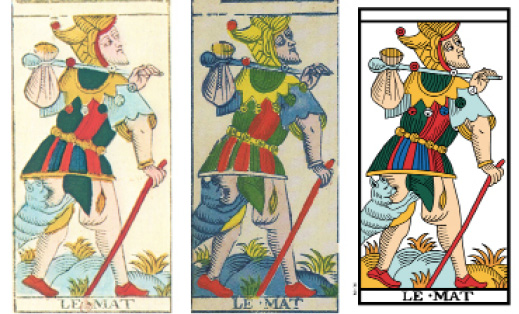
Fig. 13
Conver Fool, Heron edition
Fig. 14
Conver Fool, Scarabeo edition
Fig. 15
Conver Fool, Dal Negro Restored edition
It would not escape even the most superficial observer that, however much it might amaze, the result of the restoration of the 1760 Conver edition, is surprisingly similar to a deck well known to the general public. In fact, this correspondence exists, and is obvious. On the contrary, it would be more correct to speak of a notable iconographic similarity, as this Tarot is almost identical. Where then, is the difference? Why was the need felt to carry out this painstaking task? This restored deck, as must now be evident, is none other than the reclamation of an antique work. As the restorer of a marvellous painting does not claim its paternity, although he has worked hard to reconstruct it, the same was done in this case; the images renovated and presented here, are and will always be free from any and all presumed copyright. The Tarot is an instrument created for man in ancient times, in order to educate him (in the etymological sense of ex-ducere ,) to help him to externalize that which he carries already inside himself, to guide him along the way, to lead him towards the comprehension of a superior and spiritual sense of existence, counselling him at the same time in even the most ordinary and practical choices of his daily life. We might say that the Arcana are an Abode of that Wisdom, of that Sophia , which helps us to realize the fullness of our inner Temple. This Abode must then be accessible to all of us, because it is “ neither a grotto for the perfect, nor a castle for the privileged . 124 ” As the Gospels remind us, “ No one lights a lamp and then puts it under a basket. Instead, a lamp is placed on a stand, where it gives light to everyone in the house . 125 ” With words again borrowed from a true master if wisdom such as Raimon Panikkar, we repeat that as humans in the difficult attempt to be of support, one for the other, “ we must not hide this wisdom, neither must we protect or defend it. Thus as a free man goes weaponless about his affairs, an honest house in an authentically human culture has no need of defence systems, electronic or otherwise. True Wisdom needs no bodyguard, nor a copyright . 126 ”
He who writes has spent and spends his life investigationg the Tarot, studying it and collaborating with many researchers in the sector. As Tradition teaches, each of us is born with a gift which, once found and placed at the service of others, reveals itself to be a source of the greatest joy. At the same time, for those who search with sincerity, the Tarot becomes an illuminated Master, pure, true, and faithful. This beacon of knowledge teaches that we must not claim any intellectual property of Knowledge, unless one wishes to commit the iniquity of plagiarism or the wicked deed of egotistic appropriation of a creation which, as a Sacred Work, belongs to all humanity. These are the motives for the choice to carry out this restoration which allows anyone who so desires to utilize freely the ancient and perfect deck of the Tarot of Conver. It is none other than the work of a simple disciple aware of the urgencies of his times, difficult and in many aspects, uncertain and reckless. From everywhere is invoked the necessity of more sensitivity and deeper awareness and with this work we wish to offer our own small contribution.
The Tarot can be a powerful aid and, when widespread and understood, can invest those whom it touches with an illuminating and conscious energy, be they tarologists or consultants. Its Wisdom is immense and its desire is to bring Light to the hearts of all human beings, becoming inspiration for some, helping also to expose those who strive to limit them to exclusively personal and private use. With maximum respect for the aspirations, even strictly commercial, of anyone, we hope that they who sincerely wish to investigate in depth the meaning of these images will do so. And that, once learned in a serious and disciplined manner, they can and will propagate, as a wave in the sea, through writings or direct transmission, without limits or cost, the enormous Knowledge of the Tarot.
The task, sufficiently arduous in itself, does not require egotistical goals of the single individual, but the dedication and altruistic collaboration of the group:
“As great as the universe, is the space in the heart. There are the heavens and the earth, the fire and the wind, the sun and the moon, the lightening and the stars, that which is and that which is not, all is contained therein. 127 ”